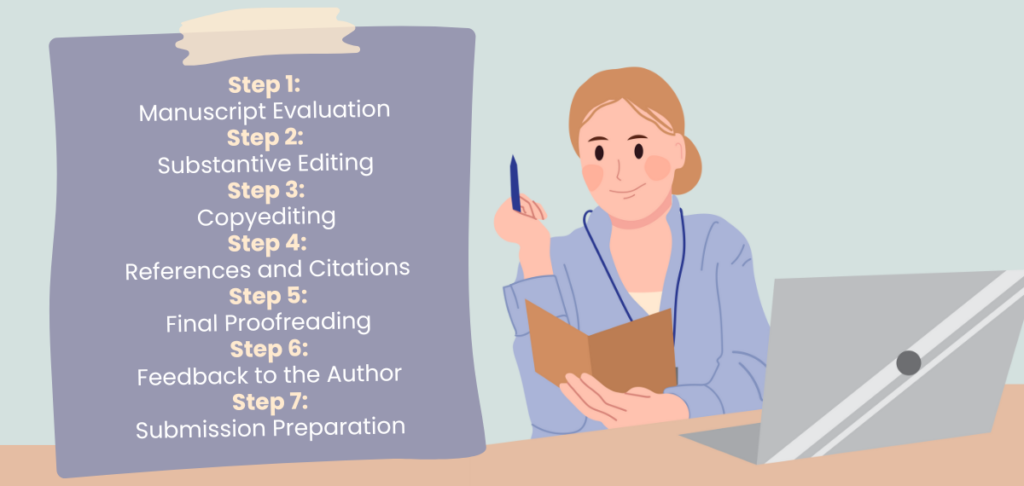Academic editing involves more than just applying edits to academic work. It also involves refining scholarly manuscripts to ensure adherence to academic standards. Academic editing plays a crucial role in scholarly publishing, enhancing the readability and impact of research findings.
As a writer, I know how valuable a good academic editor is for copyediting, proofreading, and upholding academic ethics. This type of content can be heavily involved and often communicates extremely sensitive information in terms of numbers, percentages, statistics, and more. It’s paramount that these details be conveyed correctly.
So, I created this quick but comprehensive guide to light the path for editors, researchers, and students, offering some important insights into the nuances of academic editing, from understanding different editing types to navigating academic ethics and utilizing style guides like APA, MLA, and Chicago.
Ready to learn all about the precision that academia demands? Buckle up!
What Is the Scope of Academic Editing?

Academic editing goes beyond mere proofreading; it’s a very detailed, critical evaluation and enhancement of scholarly work to check that it clearly communicates its message and meets rigorous academic standards. Whoa, that’s a mouthful! Let’s break it down into digestible parts!
Types of Academic Editing
First, we’ll dissect the four main areas of academic editing. As with any other form of written work, there are stages the content must pass through.
With novels, there’s beta reading, developmental edits, line editing, and then proofreading. The same goes for academic work, but it looks more like this:
- Substantive Editing: This phase of the editing process digs deep into the structure and content, improving the flow and clarity of the work. The editor might suggest rearranging certain paragraphs or chapters so that the document flows better from start to finish. They might also urge the writer to consider refining the formatting so that everything is presented beautifully.
- Copyediting: This focuses on grammar, spelling, punctuation, and consistency, following specific style guides. For academic work, a mix of the APA and MLA style guides is often used, but the choice is ultimately up to the writer.
- Proofreading: Just when you think it’s over, the document must go through at least one round of meticulous proofreading. This final check for surface errors like typos and poor grammar ensures the manuscript is ready for publication.
What’s in an Academic Editor’s Toolkit?
Every editor has their own methods and processes, but most have the same tools to do the job. I’ll compile these into two groups: skills/qualities and tools/software. Let’s take a quick look.
Skills and Qualities
Successful academic editors should possess an impeccable command of language (bonus points for a grip on multiple languages!), attention to detail, and a deep understanding of the academic field they’re editing in.
If an academic editor has mainly focused on editing papers in mathematics, they might not be suited for the field of, say, philosophy. If you want to become an academic editor, aim for a broad spectrum of studies to find work in any field.
Patience, empathy, and the ability to maintain the author’s voice while maintaining clarity are also key skills and qualities of an academic editor. But all editors should have those!
Tools and Software
Editors leverage various tools, from citation management software like EndNote and Zotero to plagiarism detection tools like Turnitin. These resources are not replacements for an editor’s work; they’re meant to help streamline the editing process to ensure accuracy and integrity in citations and content.
Why Are Academic Standards and Ethics Fundamental?
I mean, why are standards and ethics fundamental in any situation? They help hold everyone accountable for the content’s quality and accuracy.
Importance of Academic Standards
Most scholarly writing is meant to teach and inform the general public. Adhering to ethical standards in academic editing upholds the integrity of scholarly work and reinforces trust in academic publishing. It involves ensuring all sources are correctly cited and the work is totally original.
Style Guides for Academics
Academic writers and editors should be familiar with academic style guides (APA, MLA, Chicago, etc.). These guides provide a roadmap for correctly formatting citations, structuring manuscripts, and ensuring consistency across academic disciplines.
With academic writing, documents are usually riddled with citations, proving where the source of things like quotes and statistics came from. Style guides outline exactly how the writer should format these in the document so that everyone can see and understand them.
Tips for Academic Editing
Clear, accurate, and consistent editing in academic writing means having a good handle on understanding the subject matter. Also, a keen eye for minute details and the discipline to follow through with preserving the author’s intended meaning are the main things to keep in mind as an academic editor.
What Is the Process of Academic Editing?

The process is pretty similar to any other editing route, except for citation and formatting. Here’s a quick step-by-step guide through the academic editing process to give you an idea:
Step One: Manuscript Evaluation
Start with a thorough reading of the manuscript to understand its core arguments, structure, and flow. Don’t make changes yet; just note potential areas for improvement.
Evaluate the manuscript’s organization, clarity, and adherence to academic standards. Identify and note sections that really need restructuring, clarification, or even elaboration.
Step Two: Substantive Editing
First, addressing the structure. This involves rearranging paragraphs or sections to enhance the logical flow. You can suggest additions or deletions where necessary to strengthen arguments or eliminate redundancy.
Don’t apply these major changes just yet, though. You should apply them as editing marks or notes and then discuss with the writer whether or not it affects their vision for the piece.
Step Three: Copyediting
Focus on sentence-level corrections—grammar, punctuation, spelling, and style. Apply the relevant academic style guide (APA, MLA, Chicago) so that there’s consistency in things like the citations and formatting.
Then, refine sentences and paragraphs for clarity. Check that technical terms are defined and that the manuscript is wholly accessible to its intended audience.
Step Four: References and Citations
Now, check all citations for accuracy and completeness. The references should be formatted according to the chosen academic style guide.
Verify that all in-text citations match the reference list and that hyperlinks (if any) are functional.
Step Five: Final Proofreading
Go through everything one more time to catch any lingering typographical, spelling, or punctuation errors. This is the last line of defense to ensure the manuscript is error-free.
The manuscript’s layout, including figures, tables, and page numbers, should be correctly formatted and visually appealing.
Step Six: Feedback to the Author
This is where you present your final work to the written piece and have a chat with the writer so that they understand the changes you’ve made. Also, if you have any constructive criticism, now’s the time to offer it.
Step Seven: Submission Preparation
This is often done by the writers themselves, but they might ask the editor to prepare it. So, check and make sure the manuscript meets the submission requirements of the target journal or publisher, including abstract, keywords, and any supplementary materials. These requirements are usually found on their website or in the brief that was provided to the writer.
Balancing the Author’s Voice
The author’s voice needs to be maintained throughout while necessary adjustments are made for clarity and coherence. Sometimes, that means sacrificing format for style or allowing regional spellings and preferences while still finding a way to make the document meet publishing standards. It’s a delicate balance, but that’s the editor’s job!
Handling Technical Terms and Complex Information
Academic editors will encounter specialized jargon and complex concepts. There’s just no getting away from it. A clear understanding of the subject matter and the target audience’s knowledge level can help refine the content so that it communicates perfectly.
Best Practices When Working with Authors
Open, respectful communication and clear, constructive feedback are the cornerstones of a productive editor-author relationship. The editor should leave behind their own personal opinions on the subject matter and act as an unbiased guide through the process.
Try to keep all communication neat and accessible via an email thread or designated space in apps like Slack or Google Chat.
Addressing Sensitive Issues
Steering through sensitive issues like plagiarism or authorship disputes requires tact, professionalism, and adherence to academic and ethical guidelines.
Editors should calmly and professionally remind the author of the industry practices and standards and point out how others might react to things like plagiarism or the use of insensitive content.
Interdisciplinary Research Editing
Editing interdisciplinary research can sometimes present unique challenges. Here are some of those challenges and tips for dealing with them:
- Diverse Terminologies: Create a glossary for specialized terms or ask the writer to provide clear definitions within the text.
- Varied Methodological Approaches: Encourage authors to explain methodologies clearly and concisely. They could even consider adding a methodology section to the document.
- Inconsistent Citation Styles: Pick a single citation style that is most relevant to the research or the one most commonly used by the target publication.
- Addressing Bias: Get authors in a discussion about potential biases and strategies for their mitigation.
Digital Publishing
The rise of open access and digital publishing has totally transformed academic writing and editing.
It really emphasizes the importance of adaptability and familiarity with digital platforms in disseminating scholarly work. Digital publishing has opened doors and made academic content far more accessible to the public too.
Do You Want to Be an Academic Editor?
The importance of academic editing in scholarly communication cannot be overstated. We need it to keep a handle on the academic content coming out of various institutions and make sure the public is being informed correctly and accurately.
As editors, researchers, and students navigate their way through the complexities of academic editing, continuous learning and adaptation to new standards and practices are crucial.
If you found my guide helpful, hang around and check out some of my other helpful content on academic writing and editing!
